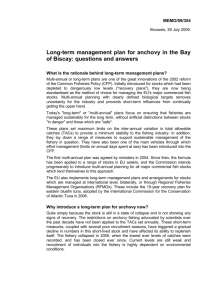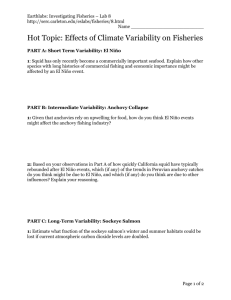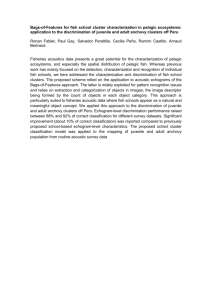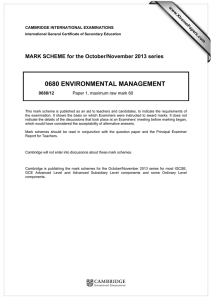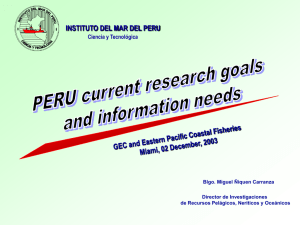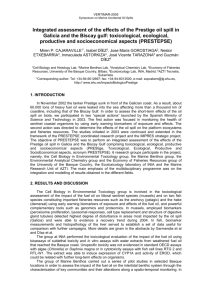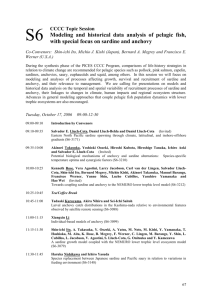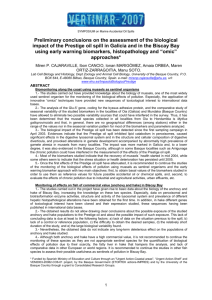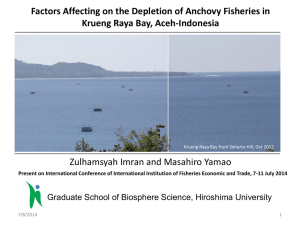Elizabeth Skewgar, , 45 (2007); DOI: 10.1126/science.1135767
advertisement
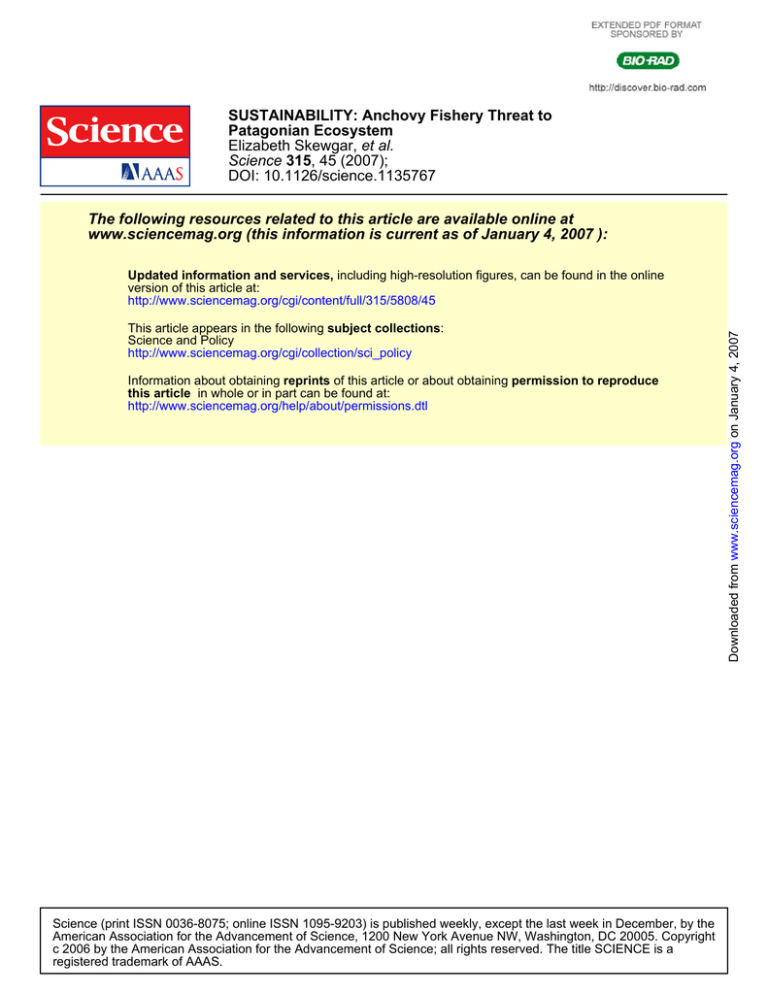
SUSTAINABILITY: Anchovy Fishery Threat to Patagonian Ecosystem Elizabeth Skewgar, et al. Science 315, 45 (2007); DOI: 10.1126/science.1135767 The following resources related to this article are available online at www.sciencemag.org (this information is current as of January 4, 2007 ): This article appears in the following subject collections: Science and Policy http://www.sciencemag.org/cgi/collection/sci_policy Information about obtaining reprints of this article or about obtaining permission to reproduce this article in whole or in part can be found at: http://www.sciencemag.org/help/about/permissions.dtl Science (print ISSN 0036-8075; online ISSN 1095-9203) is published weekly, except the last week in December, by the American Association for the Advancement of Science, 1200 New York Avenue NW, Washington, DC 20005. Copyright c 2006 by the American Association for the Advancement of Science; all rights reserved. The title SCIENCE is a registered trademark of AAAS. Downloaded from www.sciencemag.org on January 4, 2007 Updated information and services, including high-resolution figures, can be found in the online version of this article at: http://www.sciencemag.org/cgi/content/full/315/5808/45 POLICYFORUM SUSTAINABILITY Unsustainable anchovy harvest could disrupt ecosystem function, other fisheries, and ecotourism revenues. Anchovy Fishery Threat to Patagonian Ecosystem Elizabeth Skewgar,1* P. Dee Boersma,1 Graham Harris,2 Guillermo Caille2 CREDITS: JOEL JACOBS AND STOCKPHOTO T 1Department of Biology, University of Washington, Seattle, WA 98195, USA. 2Fundación Patagonia Natural, Chubut 9120, Argentina. *Correspondence. E-mail: skewes@u.washington.edu Magellanic penguin diet in the province of Chubut (7). The penguins also eat Argentine hake (Merluccius hubbsi), one of the commercially important fish species that prey on anchovy (8). Anchovy populations are naturally quite variable, and longer-lived predators are able to cope with this variability— as long as good years follow bad ones. Food web interactions and trade-offs among competing fisheries require a multispecies management approach (9) if Argentina hopes to recover its hake fishery and simultaneously expand an anchovy fishery. Changes in anchovy populations can alter the abundance of both their predators and their prey. The effect of a decrease in the anchovy population could spread through the food web, changing the flow of energy and abundance of species not directly linked to the anchovy. These food web interactions are not yet quantitatively understood. The spectacular wildlife of the Patagonian coast supports a thriving ecotourism industry. The Province of Chubut reported U.S.$165 million of direct revenue and U.S.$300 million of indirect revenue from tourism in 2005 (10), over half of which is associated with the biodiversity of the coast. If anchovy fishing reduced seabird numbers, especially of penguins, this revenue would be jeopardized. Once a fishery is established, social pressures make it politically difficult to reduce fishing effort. The Argentine government declared a state of emergency for hake in 1999, when the hake fleet capacity exceeded the legal Total Allowable Catch (TAC) by a factor of three (11). The government faced stiff opposition to emergency fleet-specific bans to prevent further overfishing (8). Biologically rational decisions may not be politically possible once investment has occurred. Argentine officials seek to provide employment and to generate revenue from an anchovy f ishery. But before any further expansion and investment takes place, the costs to other fisheries, risks to wildlife www.sciencemag.org SCIENCE Published by AAAS VOL 315 and ecotourism, and food web interactions need to be determined. Costs and risks can then be weighed against the anticipated benefits under various management options. A conservative (precautionary) TAC, leaving a safety margin for natural fluctuations and unanticipated food web interactions, is needed to prevent overfishing and overinvestment. For adaptive management, data on ecosystem status, indicator species’ populations over time, and food web interactions are needed to build quantitative understanding and to inform future management decisions. Downloaded from www.sciencemag.org on January 4, 2007 he Patagonian coast is famous for its charismatic megafauna—Magellanic penguins, southern right whales, southern elephant seals, and southern sea lions— but the small, less charismatic southwest Atlantic anchovy is a key trophic link in the ecosystem (1). Overfishing anchovy could disrupt energy flows in the southwest Atlantic ecosystem, harm other fisheries and wildlife, and damage the valuable ecotourism sector. In 2003, Argentina’s Federal Fisheries Council (CFP) approved a plan by the Province of Chubut for an experimental program to develop a small-scale trawler fishery for the “under-exploited” anchovy in provincial waters south of 41°S, partially as an alternative to the overfished hake (2). The plan notes the proximity of the Peninsula Valdés (a World Heritage Site) and the world’s largest continental Magellanic penguin colony at Punta Tombo, but has no specific mechanisms to quantify the fishery’s effect on the fish and wildlife species that depend on anchovy. In both 2004 and 2005, Argentine catches exceeded 30,000 tons of anchovy for the first time in 30 years (3). Rising global demand for fish meal could fuel unsustainable anchovy fishery expansion on the Patagonian coast. Global aquaculture, which uses feeds manufactured from fish meal, increased by 50% between 1998 and 2004, and will likely continue to grow (4). Uruguay recently approved a Chilean-financed factory to process 200,000 tons of anchovy into fish meal (5). An increasing human population will create even greater demand for protein and nutrients derived from harvest of forage fish like anchovy. The southwest Atlantic anchovy (Engraulis anchoita) is a crucial intermediate step in the flow of energy through the food web, dominating the level between tiny plankton and much of the wildlife of the Patagonian shelf (1). Commercially important fish and cephalopods, penguins, cormorants, terns, sea lions, and dolphins prey on the anchovy (6). Anchovy compose more than half the References and Notes 1. A. Bakun, Progr. Oceanogr. 68, 271 (2006). 2. Consejo Federal Pesquero, Resolución 6/03; www.cfp.gov.ar/resoluciones_2002_03.htm. 3. Secretaría de Agricultura, Ganadería, Pesca y Alimentos, “Desembarques de capturas marítimas totales”; www.sagpya.mecon.gov.ar (2006). 4. Food and Agriculture Organization (FAO), Fisheries Department, The State of World Fisheries and Aquaculture (SOFIA) 2004 (FAO, Rome, 2004). 5. Presidencia de la República Oriental del Uruguay, “Se Adjudica Licitación Publica a la Firma Ibramar S.A. para Extracción y Procesamiento de la Especie Anchoíta”; www.presidencia.gub.uy/resoluciones/2002072634.htm (2002). 6. M. Koen-Alonso, P. Yodzis, Can. J. Fish. Aquat. Sci. 62, 1490 (2005). 7. E. Frere, P. Gandini, V. Lichtschein, Ornitol. Neotrop. 7, 35 (1996). 8. S. N. Schonberger, J. J. Agar, Argentina: Towards RightsBased Fisheries Management (Report no. 22816, World Bank, Washington, DC, 2001). 9. J. J. Magnuson et al., Dynamic Changes in Marine Ecosystems: Fishing, Food Webs, and Future Options (National Academy Press, Washington, DC, 2006). 10. Gobierno del Chubut, “El turismo en Chubut generó ingresos directos por 500 millones de pesos”; www.chubut.gov.ar (2006). 11. FAO Fisheries Department, “Información sobre la ordenación pesquera de la República Argentina”; www.fao.org/fi/fcp/es/ARG/body.htm (2001). 12. We thank R. T. Paine, W. Conway, W. Wooster, R. Hilborn, and two anonymous reviewers for helpful comments. E. (Skewes) Skewgar was funded by an ARCS Foundation Fellowship, a U.S. Environmental Protection Agency STAR Fellowship, and an NSF Graduate Research Fellowship. This research was supported in part by the Wadsworth Endowed Chair in Conservation Science and the Wildlife Conservation Society. The views expressed are the authors’ and not necessarily those of the sponsors. 5 JANUARY 2007 10.1126/science.1135767 45
